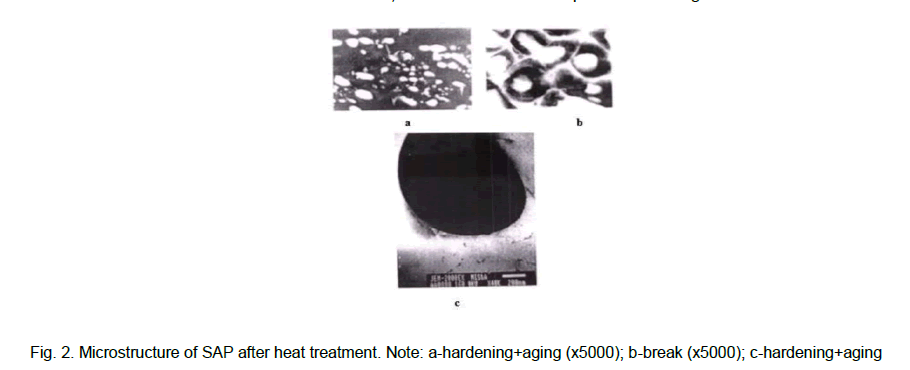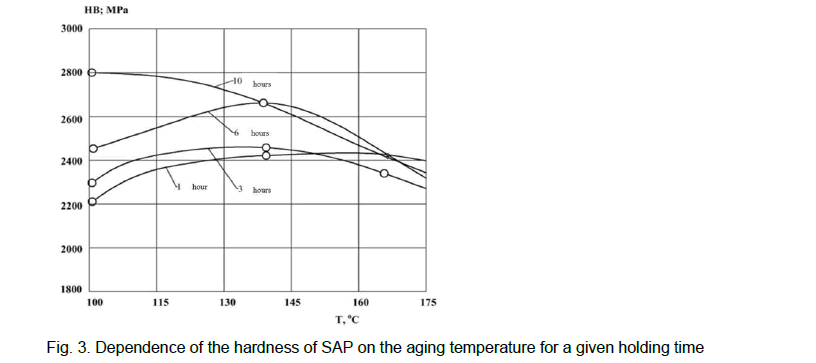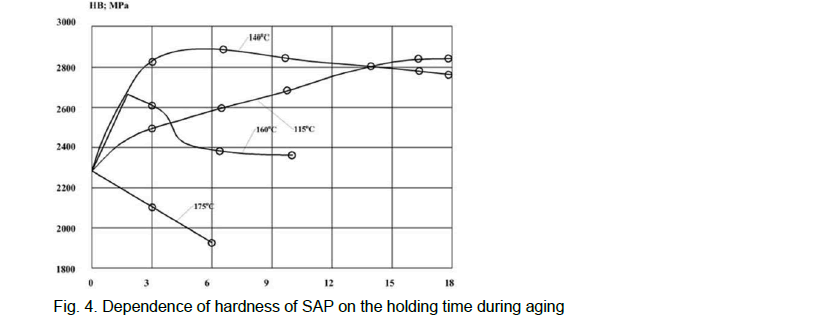
"AN INVESTMENT IN KNOWLEDGE ALWAYS PAYS THE BEST INTEREST" BENJAMIN FRANKLIN

"AN INVESTMENT IN KNOWLEDGE ALWAYS PAYS THE BEST INTEREST" BENJAMIN FRANKLIN

Research Article - (2021) Volume 58, Issue 3
, DOI: 10.36962/gbssjar/58.3.001
The features of the behavior of powder aluminum alloys alloyed with transition metals have been studied on the example of Sintered Aluminum Powder (SAP). A new alloy composition consisting of powders 5-25% Al2O3, 1.5% Cr, 1% Ni and the rest-Al has been developed. After cold pressing and subsequent sintering at 650oC, this alloy shows high strength properties and during operation at 550oC, these characteristics are almost preserved. This behavior of the developed alloy expands the area of SAP implementation and in this case it can successfully replace titanium and high-strength steels in operating conditions under the influence of temperature. For example, the proposed SAP at room temperature has a tensile strength of 400-500 MPa, and when operated above 300oC, its strength significantly exceeds the strength of the best aging aluminum alloys. The studies carried out made it possible to determine the optimal content of transition metals (nickel and chromium) in the new SAP. Their amount in the new SAP is 1.5% Cr and 1.0% Ni; it is exactly in this composition the condition of the formation of Al3Ni type solid phase is created. At the same time, the use of plastic deformation of this alloy leads to a significant increase in the complex of physical and mechanical properties
betkolik betlike betpark betticket betturkey extrabet holiganbet ilbet ikimisli imajbet jojobet kralbet mariobet marsbahis meritking milanobet piabet redwin süpertotobet tempobet
Transition metals SAP, Aluminum alloy, Strength, Corrosion resistance, Heat resistance, Dispersed phase.
It is known [1,2] that the mechanical properties of aluminum depend on the degree of purity and modes of its processing, temperature and other factors. With increasing wall purity, the strength and hardness of aluminum decreases, and the plasticity increase. So, according to R. Godot, the modules of elasticity at 20oC, for aluminum with 99.25% purity is 69.65 GPa, and for electrolytic ally refined aluminum with 99.98% purity-65.71% GPa. With the temperature rise, the strength of aluminum decreases and the plasticity increases.
At present time, powder metallurgy of aluminum and its alloys has some success. This is due to the fact that in the case of using powder technology, it becomes possible to regulate the chemical composition and structure of aluminum alloys in a wide range and desired direction. For example, using ultrafine powders of pure aluminum, its oxide (Al2O3), as well as alloying elements, the new alloys called SAP can be created.
It should be noted that Sintered Aluminum Powder (SAP) alloyed with transition metals (Ni, Cr), in comparison with conventional aluminum alloys, has a higher strength in the temperature range of 300-500oC. Unlike these alloys, SAP retains its original properties under prolonged heating (up to 10,000 hours). Our studies [3,4] show that the strength of aluminum alloys at high temperatures depending on time is very low, and the strength of SAP, alloyed with transition metals, does not change at a temperature of 500oC even after working 1000 hours. Sintered Aluminum Powder (SAP), alloyed with chromium and nickel, showed high corrosion resistance in water at the same time, testing of this alloy has shown its high heat resistance and thermal conductivity ability.
These effects obtained can be explained by the following reasons. SAP, compared with casting and pressure treated aluminum, has large crystals and consists of very small particles, i.e. powders. During operation the fineness of the powder alloy particles prevents crystalline sliding and thus, the mechanical strength of the material increases. Tests carried out at room temperature for SAP alloyed with transition metals showed that after heating to 600oC, it does not lose its strength. Even at a temperature of 1000oC, the particles of the powder alloy retain their shape if they are not subjected to mechanical stress.
The questions should embody the research methods that researches have chosen. The article provides knowledge on qualitative, which can motivate to explore, analyze and address problems in the environmental management field.
Experimental technique
A mixture of Al, Cr and Ni powders, as well as Al2O3 was prepared in the following ratio of components, mass %: chromium powder 1.5; nickel powder-1.0, aluminum oxide powder (Al2O3)-5-15, the rest-aluminum powder. 0.5 mass % lithium stearate was added to the mixture as a technological lubricant, the powders were mixed in a U-shaped container in a dry form for 40 minutes, and cylindrical (Dxh=50 × 60mm) and prismatic (10×10× 55mm) samples were pressed using a hydraulic press HPM-100 under 300 MPa pressure in a steel mold. The samples obtained were sintered in a special furnace in a vacuum of 10-3 at a temperature of 650oC, for an hour. The porosity of the sintered samples was studied by the hydraulic method; it ranged within 8-12% on the samples. Then the samples were extruded from a diameter of 50 mm to a diameter of 25 mm through an extruder at a room temperature. The samples were hardened in a glycerol medium beginning from a temperature of 500oC. The hardened samples have been undergone to natural and artificial aging for 120 hours (5 days).
The phase composition of aluminum powder alloys after extrusion, quenching and natural aging were determined at DRON-3 apparatus, and the microstructures were examined using REM-200 electron microscope and an optical microscope neophot-21.
Strength properties of powdered aluminum alloy
The change in strength, physical and technological properties, as well as the corrosion resistance of powder aluminum alloys is achieved in different ways: by cold work-hardening, heat treatment (quenching, aging), quenching from a liquid state, thermo mechanical treatment, as well as strengthening by phases not solutions of aluminum oxides, other soluble phases and the creation of composite materials with an aluminum-based matrix.
A white protective layer is formed on the surface of ordinary aluminum alloys when heated in water vapor environment at about 250oC, however at high temperature, water vapor is reactive forming aluminum oxide and hydrogen in some cases. Sintered Aluminum Powder (SAP) alloyed with Cr and Ni at a temperature at about 500oC, against water vapor is characterized by a sufficient high durability. For example, using an additive 1% Ni in SAP prevents fast material decomposition at a temperature of 300oC.
It should be noted that sintered aluminum powder alloyed with transition metals (Cr, Ni) has extraordinary properties. The results of our researches show that after extrusion and heat treatment, the strength of this alloy at room temperature is 400 -500Mpa and during operation above 300oC.Its strength is much higher than the strength of the aged best aluminum alloys. The material developed by us, even at a temperature of 500oC, retains high strength values and extremely high thermal strength.
It should also be noted that the hardening of the matrix of a sintered aluminum alloyed with transition metals is achieved with the help of aluminum oxide itself. This oxide, along with refractoriness, is also stable under various thermal effects [5,6]. Table 1 present the mechanical properties and (Fig. 1) shows the microstructure of the developed powder aluminum alloy with Al2O3 oxide and alloyed with transition metals (Cr, Ni). Table 2 presents hardness values of SAP depending on the amount of nickel in it (Tables 1 and 2).
| SAP composition | Mechanical properties | ||||||
|---|---|---|---|---|---|---|---|
| HB, MPa |  |
δ% | |||||
| Cr- | 1,5%; Ni - | 1,0%; A2O3- | 15% Al - | rest | 2000 | 450 | 2,5 |
Table 1. Mechanical properties of transition metals alloyed SAP
| Nickel amount, mass % | Hardness HB, MPa |
|---|---|
| 0 | 4500 |
| 0,5 | 1800 |
| 1,0 | 2000 |
| 1,5 | 2200 |
| 2,0 | 2300 |
Table 2. Hardness of SAP after quenching from temperature of 500oC and natural aging for 5 days, depending on the
amount of nickel
The results obtained confirm the optimal amount of nickel in the powder alloy 12%. Increasing the amount of nickel in the alloy leads to the increase of alloy hardness which is explained by the influence of inclusions of Al3Ni type phases [7,8]. At the next stage, heat treatment of SAP was carried out at the following modes: hardening-430-450oC; natural aging-3-5 hours; hardening-480-500oC; aging-5-9 hours at a temperature of 110-120oC; hardening-480-590oC, aging 3-5 hours at a temperature of 150-160oC. These modes are selected on the basis of earlier findings and the following provisions. The first stage of quenching heating is chosen so that non-equilibrium phases dissolve without burn-off. In the second stage, a more homogeneous structure is obtained. The microstructure of SAP after heat treatment has been presented (Figure 1) [9,10].
Figure 1: SAP microstructure. Note: a-unsintered alloy; b-e-sintered alloy× 750. Sintering temprtaure,oC b- 650oC; c-670oC; d- 680soC; e-700oC
However, to reduce the duration of the heat treatment of SAP, the first stage of hardening and aging should be eliminated. For this, depending on the holding time, kinetic curves of changes in hardness were constructed at different temperatures of artificial aging (Fig. 3).

Figure 2: Microstructure of SAP after heat treatment. Note: a-hardening+aging (x5000); b-break (x5000); c-hardening+aging
As the results of the experiment show, it is possible to replace two-stage aging with one-stage; this gives a significant gain both in time and in the labor intensity of the process. At the same time, the heating temperature and holding time during aging correspond to the previously recommended modes (155oC, 3-5 hours). However, for a full conclusion and the expediency of using one-stage aging, it is necessary to determine other properties of the composite alloy.
Table 3 shows the effect of the nickel content in SAP and the holding time at the second stage of aging on the hardness of the samples. Data of changes in the hardness of SAP samples after aging and extrusion are presented in Table 4.
| Holding time of SAP during second stage of aging, hour | Nickel content in SAP, mass% | ||||
|---|---|---|---|---|---|
| 0 | 0,5 | 1,0 | 1,5 | 2,0 | |
| 2 | 1200 | 1360 | 1520 | 1630 | 1700 |
| 5 | 1350 | 1520 | 1610 | 1710 | 1720 |
| 8 | 1440 | 1780 | 1750 | 1800 | 1810 |
| 12 | 1560 | 1800 | 1790 | 1820 | 1800 |
Table 3. Hardness of SAP with different nickel content in the second stage of aging, MPa
| Holding time at 20 C, hour |
Aging temperature of the second stage C | Second stage holding time, hour |
SAP hardness | |
|---|---|---|---|---|
| After aging (HB) | After extrusion (HV) | |||
| 1 | 2 | 3 | 4 | 5 |
| 0.25 | - | - | 80 | 103 |
| 1 | - | - | 114 | 115 |
| 24 | - | - | 139 | 127 |
| 120 | - | - | 150 | 131 |
| 1 | 100 | 1 | 155 | 139 |
| 1 | 100 | 20 | 187 | 184 |
| 24 | 100 | 1 | 164 | 155 |
| 24 | 100 | 3 | 172 | 164 |
| 120 | 100 | 1 | 154 | 151 |
| 120 | 100 | 3 | 175 | 156 |
| 1 | 150 | 1 | 175 | 152 |
| 1 | 150 | 3 | 178 | 162 |
| 24 | 150 | 1 | 181 | 162 |
| 24 | 150 | 3 | 187 | 163 |
| 120 | 150 | 1 | 181 | 164 |
| 2 | 175 | 1 | 180 | - |
| 2 | 175 | 3 | 153 | - |
| 20 | 175 | 1 | 174 | - |
| 2 | 200 | 1 | 138 | - |
| 2 | 200 | 3 | 121 | - |
| 20 | 200 | 1 | 136 | - |
Table 4. Influence of aging regime on SAP hardness
As it is seen from Table 3, the hardness of SAP containing 1.0% Ni is almost equal to the hardness of SAP containing 1.5 and 2.0% Ni even after heat treatment. Therefore, this information confirms the correctness of the choice of SAP containing 1.0% Ni. Figure 3 shows the change in the hardness of SAP depending on the temperature of artificial aging, from which it can be seen that at a holding time of 10 hours with an increase in the aging temperature, the hardness of the samples slightly decreases, whereas at a short holding time. i.e.at τ <10 hours, the hardness first increases, and then decreases somewhat. This is due to a decrease in the stress state of SAP, created as a result of dispersion hardening.

Figure 3: Dependence of the hardness of SAP on the aging temperature for a given holding time
Now let us consider how the aging time affects the hardness of SAP samples (Fig. 4). For samples aqged at a low temprature (115oC), an increase in aging time leads to an increase in hardness. However, at high aging temperatures, with an increase in the holding time, the hardness of SAP sharply increases, which is explained by a decrease in the stress of the samples and an increase in the size of dispersed inclusions [11]. Table 5 presents the strength and hardness data for SAP after extrusion and heat treatment (quenching+aging) (Tables 4-6).

Figure 4: Dependence of hardness of SAP on the holding time during aging
| Conditin | HV |
d, MPa |
|
|---|---|---|---|
| After Extrusion at 460oC and heat treatment (quenching at 520oC and aging at 130oC-5 hours+150oC-4 hours) |
155 |
480 |
3 |
Table 5. Average values of mechanical properties of SAP
| Composition | HB210 | HB280 |
|---|---|---|
| SAP (Cr 1.5, Ni 1.0) | 380 | 250 |
| SAP (no Ni) | 260 | 100 |
Table 6. Long-term hardness of SAP without Ni and with Ni, MPa
Table 6 shows the positive effect of inclusions of the eutectic phase of the Al3Ni type on the heat resistance of SAP. It can be seen from the table that, in comparison with the SAP that does not contain Ni, the SAP containing Ni has a higher heat resistance, that is, with an increase in the test temperature, the decrease in hardness becomes insignificant. These data indicate that the proposed SAP, alloyed with transition metals, can exhibit characteristics of longer heat resistance.
A new powder material of SAP type has been developed. The powder charge contains 5-25% Al2O3, 1.5% Cr, 1% Ni and the rest-Al. This material has high strength and performance properties after sintering, extrusion and heat treatment (hardening+aging). This material will almost retain its basic properties during operation at 550oC. At room temperature, the tensile strength of the developed powder SAP is 400-500 MPa, at temperature above 300oC its strength significantly exceed.